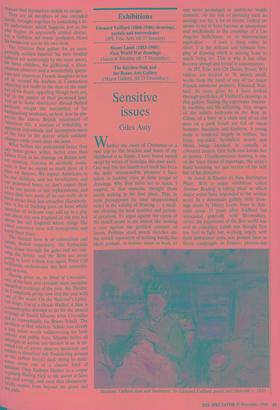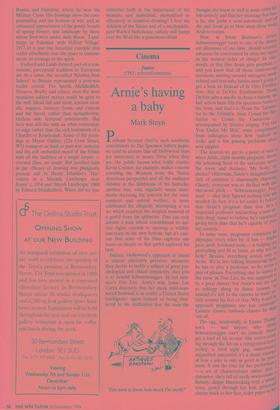Exhibitions
Edouard Vuillard (1868-1940): drawings, pastels and watercolours (JPL Fine Arts, till 27 January) Henry Lamb (1883-1960): First World War drawings (Jason & Rhodes, till 17 December)
Sensitive issues
Giles Auty
Whether the onset of Christmas or a rare trip to the beaches and lanes of my childhood is to blame, I have found myself swept by waves of nostalgia this past week. One way this has manifested itself has been the quite unreasonable pleasure I have taken in looking even at little scraps of drawings. Why they move me so much, I suspect, is that someone thought them worth making in the first place. This, in turn, presupposes the once unquestioned belief in the validity of drawing — a medi- urn allowing the most sensitive and person- al notations. To argue against the caress of the pencil seems to me almost like making a case against the gentlest contacts of lovers. Perhaps small pencil sketches are the artistic equivalent of holding hands, the likely prelude, in former times at least, to
any more prolonged or ambitious bodily contacts. At the risk of pursuing such an analogy too far, a lot of recent, radical art seems to me to have become as anonymous and mechanistic as the couplings of a Los Angeles bath-house or its heterosexual equivalent — if such a thing exists. In short, it is the delicate and intimate fore- play of drawing which is missing from so much living art. This is why it has often become abrupt and brutal in consequence.
At JPL Fine Arts (26 Davies Street, W1) visitors are treated to 70, mostly small, works from the hand of one of the major French intirnisme painters, Edouard Vuil- lard. In years gone by I have looked through portfolios of Vuillard's drawings in this gallery, finding the experience intense- ly soothing and life-affirming. Tiny images of the artist's bedroom in the Rue de Calais, of a baby in a chair and of an old man on a park bench are full of visual humour, humanity and kindness. A young nude is rendered largely in outline, her large, lop-sided, lip-sticked mouth and blond bangs knocked in casually in coloured crayon. One feels one knows her in person. Unselfconscious drawing is one of the truer forms of reportage, the artist's hand revealing not just secrets of his skill but of his character.
At Jason & Rhodes (4 New Burlington Place, W1) a major exhibition called Another Reading is taking place in which major artists have responded to the written word. In a downstairs gallery, little draw- ings made by Henry Lamb, born in Ade- laide some 15 years after Vuillard but associated generally with Bloomsbury, revive the experience of the first world war and its casualties. Lamb was thought first too frail to fight but, working largely with field ambulance units, was present later at fierce campaigns in France, present-day 'Madame Vuillard dans tine Inteneure', by Edouard Vuillard, pastel and charcoal, c. 1920 Bosnia and Palestine, where he won the Military Cross. His drawings show the com- panionship and the horrors of war, and an enhanced appreciation of the gentle beauty of spring flowers and landscape by those whose lives were under daily threat. 'Land- scape in Palestine with Hilltop Village' 1917-18 is just one beautiful example that vaults effortlessly over the years to commu- nicate its message to the spirit.
Vuillard and Lamb formed part of a con- tinuous, perceptual tradition in European art. In a sense, the so-called 'Kitchen Sink School' in Britain represented a post-war realist revival. For Smith, Middleditch, Greaves, Bratby and others, even the most mundane subject matter could be grist to the mill. Dead fish and meat, kitchen uten- sils, nappies, lavatory bowls and cisterns and the literal, rather than metaphorical, kitchen sink featured prominently. But here was still-life with an often existential- ist edge rather than the rich humanism of a Chardin or Rembrandt. Some of the paint- ings at Mayor Gallery (22a Cork Street, W1) transport us back to post-war austerity and the still embattled mood of the Fifties with all the facilities of a magic carpet — coconut fibre, no doubt. But justified faith in the efficacy of drawing was plangently present still in Henry Inlander's 'Har- vesters in a Moonlit Landscape near Rome' c. 1954 and 'Marsh Landscape' 1960 by Edward Middleditch. When did we lose collective faith in the importance of the intimate and individual, exemplified so effectively in sensitive drawing? I fear the sickness of the Sixties and of a mechanistic, post-Warhol bath-house culture still hangs over the West like a poisonous cloud.



































































 Previous page
Previous page